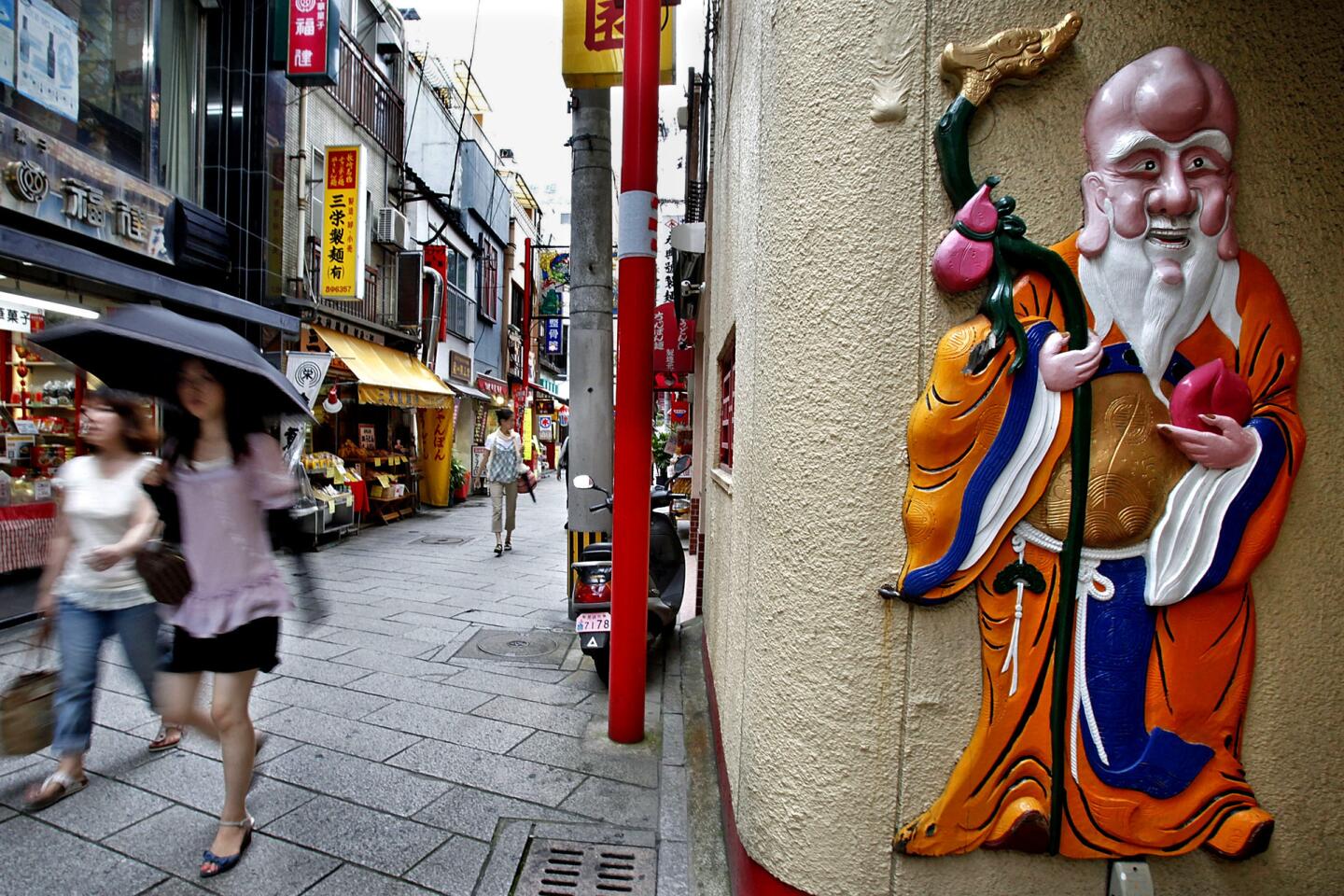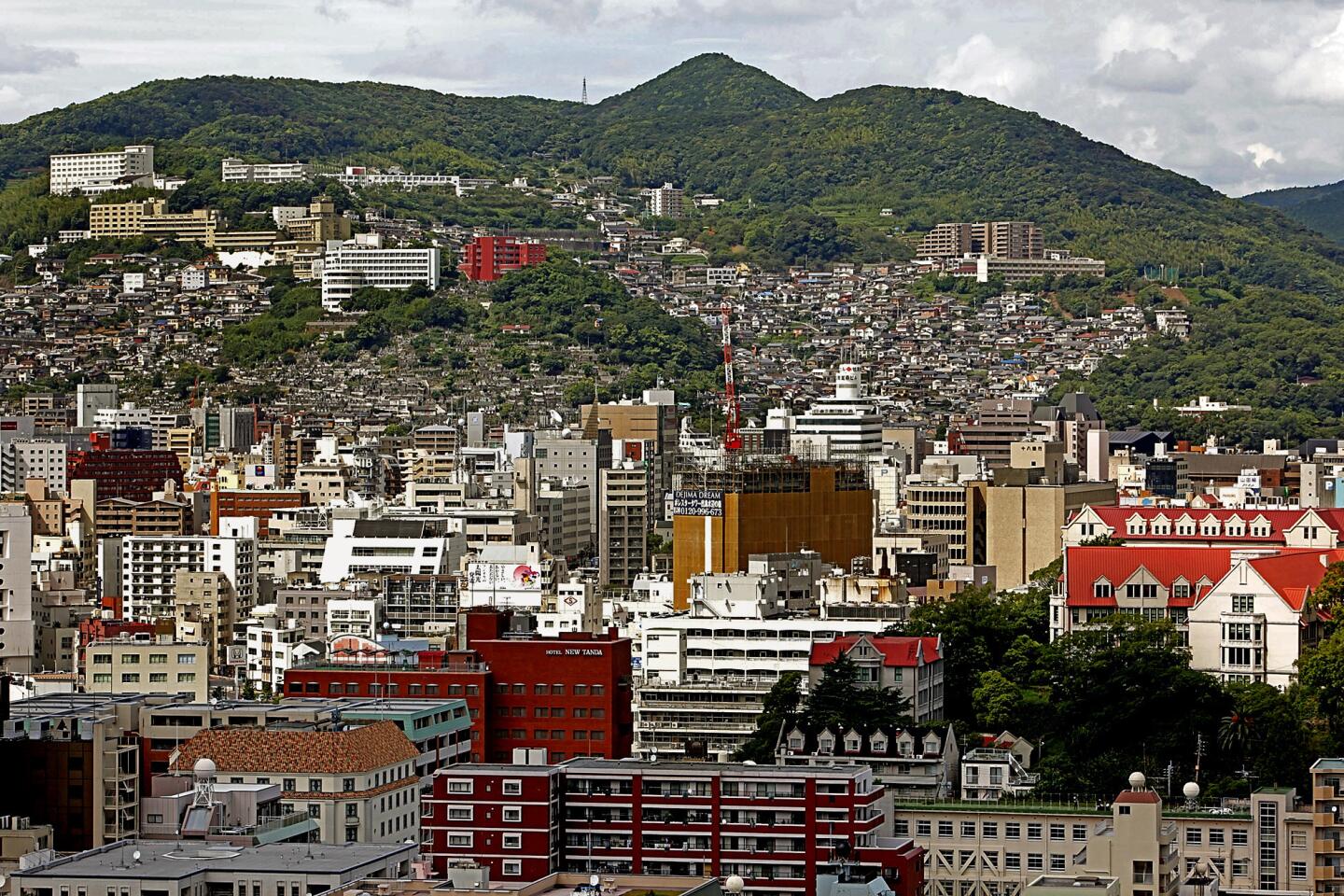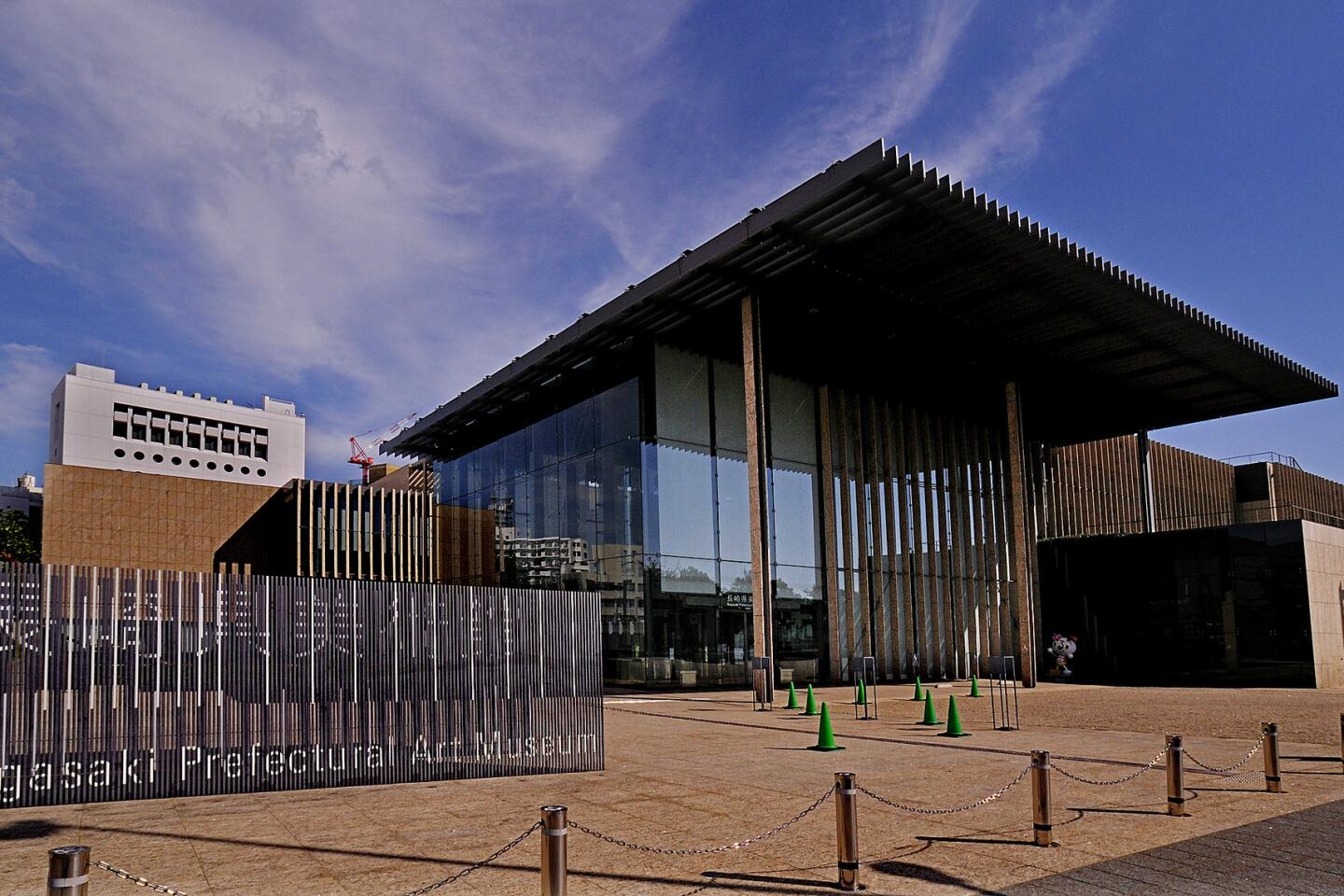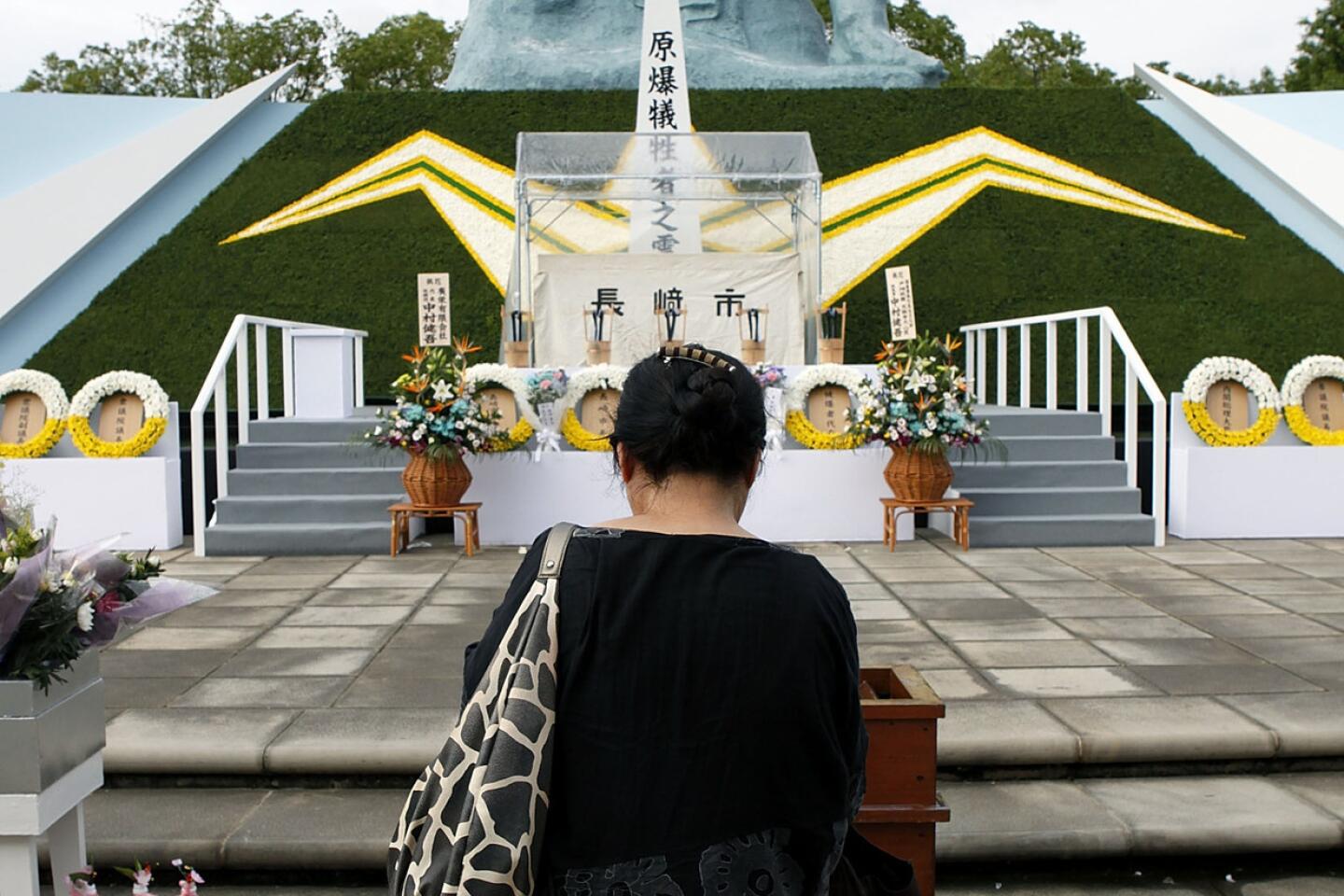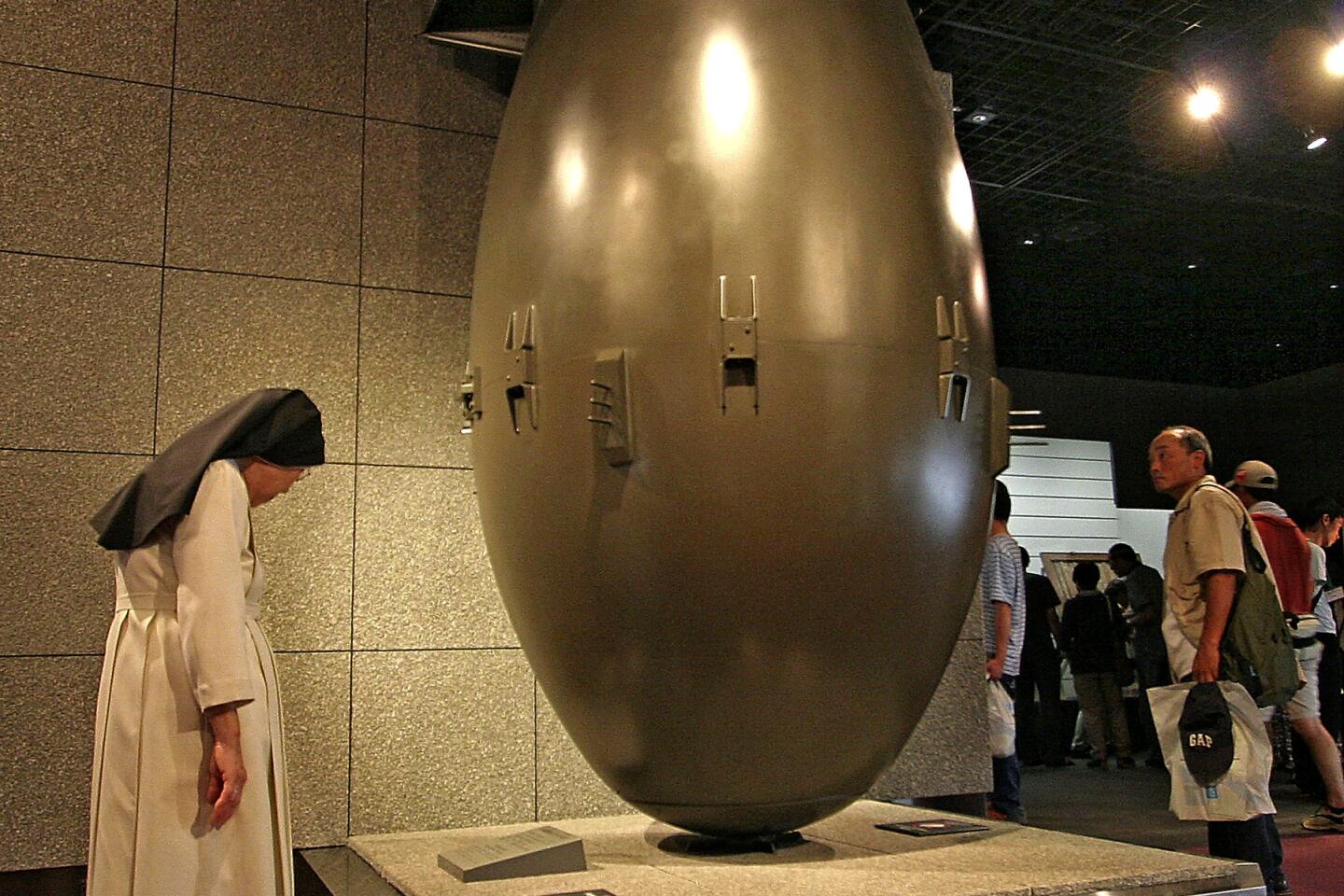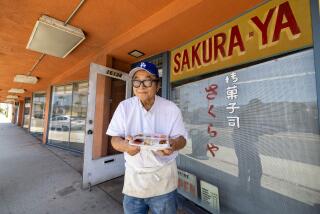Japanese port city of Nagasaki has long East-West connection
- Share via
NAGASAKI, Japan — On my first trip to Nagasaki, just out of college, I knew what most of the world knows: An atomic bomb fell here on Aug. 9, 1945, bringing World War II to a close. It wasn’t until my second visit, more than 20 years later on a guidebook assignment, that I realized how much I had missed.
Although the A-bomb is rightfully front and center for overseas visitors, the Japanese concept of the city is very different. As Japan’s westernmost major port, it was the nation’s first landing spot for Catholic missionaries and martyrs; red-bearded, waistcoated, fancy-hatted traders; and exotic foods borne by trade winds. For two centuries it was the sole point of encounter between Japan and the outside world.
That all makes Nagasaki one of Japan’s most compelling destinations. By my reckoning, were it not for its remote location Nagasaki would be one of the nation’s most-visited cities.
East-West exchange here dates to the 1540s, when Portuguese explorers and Catholic missionaries (including St. Francis Xavier) appeared on the shores of Nagasaki prefecture. They brought with them firearms, Christianity, and other ways deemed harmful to Japanese social order. Then in 1641, the shogun, or chief military ruler, expelled all foreigners from Japan and closed the island nation to the rest of the world.
The sole exception: A Dutch trading post was allowed to remain on a man-made island in Nagasaki Bay. The Dutch were deemed more about trade than colonization, and their Calvinist faith less activist than Catholicism. The island provided a trickle of Western culture into the city that lasted until 1859 when Japan tentatively reopened to the outside world. That history left Nagasaki a uniquely cosmopolitan ethos that pervades today.
The biggest difference between my first and subsequent trips was the painstaking reconstruction of the former island trading post, Dejima, into a 3.8-acre village. Collectively, the hybrid Dutch-Japanese buildings, opened to visitors in 2006, feels analogous to a compact Colonial Williamsburg in Virginia. If you’ve read David Mitchell’s novel “The Thousand Autumns of Jacob de Zoet,” set on Dejima, the surroundings will seem familiar.
Among the 17 buildings restored to date, I was especially taken with the residence of the chief factor (station chief), which combines Japanese elements, such as tatami mat flooring, with Western, such as wallpaper, a pool table and a large dining room with an Oriental carpet, table and chairs (Japanese at the time would have sat on tatami). Former warehouses and officers’ quarters are dramatically lighted with exhibits about the trading post, which brought me back to my third-grade fascination with explorers. The perilous, triangular trade route circulated blue-and-white pottery from Japan, spices and exotic textiles from India, and technology such as globes, medicines and photography from Europe.
Meanwhile, on a hill near Nagasaki Station, a monument pays tribute to the martyrdom of 26 Christians in the military crackdown of 1597. Although the shogun banned Christianity in the 17th century, many Christians continued to practice in secret; some worshipers kept statues of Maria Kannon, combining imagery of the Virgin Mary with Kannon, the Buddhist deity of mercy, in hopes of eluding authorities looking for Christian icons.
After Japan opened more ports beginning in the 1850s (including Yokohama near Tokyo and Hakodate, on the northern island of Hokkaido), traders from other countries began to set up shop around Nagasaki harbor. Today, many of their homes and warehouses have been relocated, rebuilt and fitted with period artifacts in the rambling hillside park called Glover Garden. South of the city center, it’s named for Thomas Glover (1838-1911), a Scottish trader who, among other accomplishments, built Japan’s first railway. If you’ve toured historic homes in New England, the Victorian architecture and design will feel familiar, but I’m always struck by how the Japanese ooh and ahh (or, rather, eiiiii and haaaa). It made sense when I realized how otherworldly this furniture and furnishings were for Japan at the time.
I also found captivating the views from Glover Garden across the busy shipyards in the harbor to the city below and the gumdrop-shaped hills surrounding it. There’s also a statue of Madama Butterfly in Glover Garden in tribute to the novel and Puccini opera set in Nagasaki, and a museum filled with videos and objects used in the city’s annual Kunchi Festival (Oct. 7-9), in which colorful dragons and tall floats parade through the streets. The Dutch Slopes, a 10-minute walk away, show other homes in their original locations and now house old-school museums of photography and archaeology.
My next surprise: Just downhill from the Dutch Slopes is Koshi-byo, the largest Chinese-built Confucian shrine outside of China. Amid its bold reds and yellows and courtyards lined with statues of sages, I felt transported back to the Middle Kingdom. Behind it, the Historical Museum of China shows off precious jades, Neolithic artifacts and terra-cotta warriors and has a Chinese gift shop selling the silly to the sublime.
If you can’t make it to all these sights, Nagasaki Museum of History & Culture tells the city’s story in a gorgeous presentation. Part of the building is the reconstructed quarters of the Edo period magistrate, who oversaw diplomacy and trade from within its massive stone walls.
Amid all this foreign influence, the city never lost its Japanese-ness. Most impressive of Nagasaki’s Shinto precincts is Suwa Shrine, on a steep hill and well worth the climb for the inspiring views across the bay. Around the grounds are statues of a variety of komainu (protector dogs), fun to play with. Another district, Teramachi, links a string of Buddhist temples along a side street for an inspirational, hour-or-so trek if you make many stops.
For all Nagasaki’s history, I was surprised at how current it is. Exhibit A: the Nagasaki Prefectural Art Museum, opened in 2005 and designed by architect Kengo Kuma, whose other works include Tokyo’s Nezu Museum and flagship Tiffany shop. His green building seems to float above a canal near the harbor and houses a permanent collection of Nagasaki-related and Spanish art. If you like the architecture, it’s worth staying in, or at least dining in, another Kuma work, Garden Terrace Nagasaki, clad in geometric patterns of wood slats and perched high on a hill — I thought the views alone were worth the effort to get there.
The other reason Nagasaki is one of my top Japanese destinations: the food. Portuguese, Chinese and Japanese influences combined to give Nagasaki one of the world’s first fusion cuisines. My favorite combo is shippoku-ryori, an assortment of tiny bites on a dozen or more colorful dishes. Typical shippoku-ryori dishes include kakuni (Chinese-style stewed pork belly), tempura, stews, soboro (chopped meat over rice) and more. I like Shippoku Hamakatsu restaurant, which serves relatively inexpensive shippoku-ryori at prices starting around $31 for a filling bento in an elegant lacquer tray.
Among Japanese, Nagasaki’s favorite main dish is the noodle soup called champon. The name is Japanese for mishmash, and it looks like conventional ramen except that the broth is typically cloudy white and topped with seafood and vegetables for a flavor that’s much subtler than the hearty tonkotsu (pork broth) ramen famous in nearby Fukuoka. Shikairo, near the entrance to Glover Garden, claims to have invented it.
For straight-up Chinese, I go to the old standby, the Shinchi Chinatown neighborhood. Restaurants large and small cater to all budgets with simple noodle dishes and set lunch menus to Peking duck extravaganzas. Afterward, it’s fun to browse nearby shops for colorful trinkets.
The other taste that most Japanese associate with Nagasaki is castella, a sweet, dense pound cake of Portuguese origin and very refreshing when served with iced or hot tea. Pound cake may not seem exotic to Westerners, but until the lst half-century or so it was a rare treat to most Japanese as typical homes did not have ovens. Japanese tourists still bring shopping bags full of brick-sized castella home with them as gifts from ubiquitous merchants such as Bunmeido, but I prefer atmospheric Fukasaya, which has been making castella since 1624.
For all the city’s charms, whenever people talk about Nagasaki, there’s an elephant in the room: the atomic bombing. Indeed, it’s important for the soul to allow at least half a day — more if you can handle it, as it is gut-wrenching — at the sites, just two miles north of the historic districts (a tram makes getting there easy).
A black stone column marks the place where the bomb, nicknamed Fat Man, exploded some 1,600 feet above the ground, and around the Peace Park are statues donated by nations as a prayer for peace. The nearby Nagasaki Atomic Bomb Museum tells of the city’s devastation and the instant death of 74,000 of Nagasaki’s 240,000 residents.
A few hundred yards away is the Urakami Cathedral, until the bombing the largest Catholic church in Asia. Although the replacement cathedral, completed in 1959, is smaller than the original, it sits on the ruins of its predecessor and has taken on a new life in a new age.
To my mind, that’s Nagasaki in a nutshell: Whatever the bombing did to diminish the city, its foundation is strong, and today it thrives.
More to Read
Sign up for Essential California
The most important California stories and recommendations in your inbox every morning.
You may occasionally receive promotional content from the Los Angeles Times.
